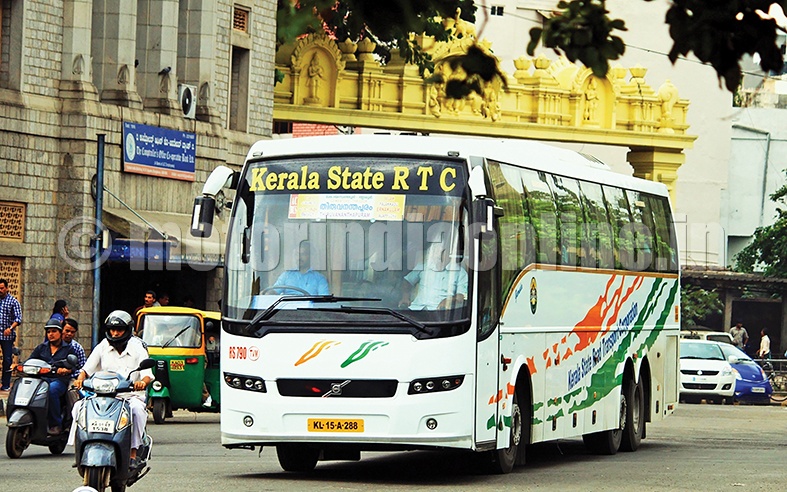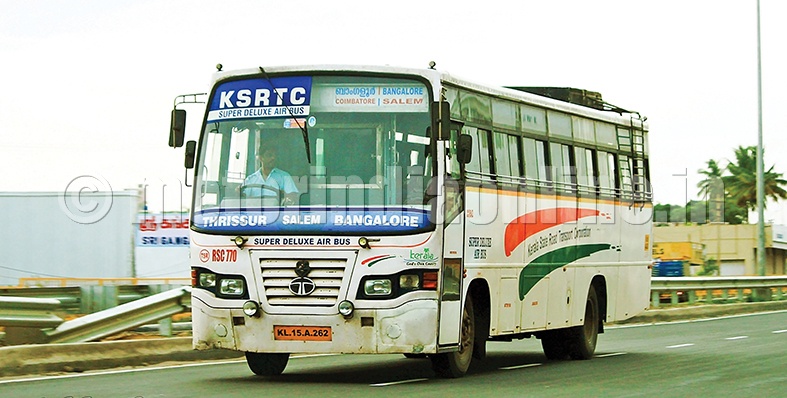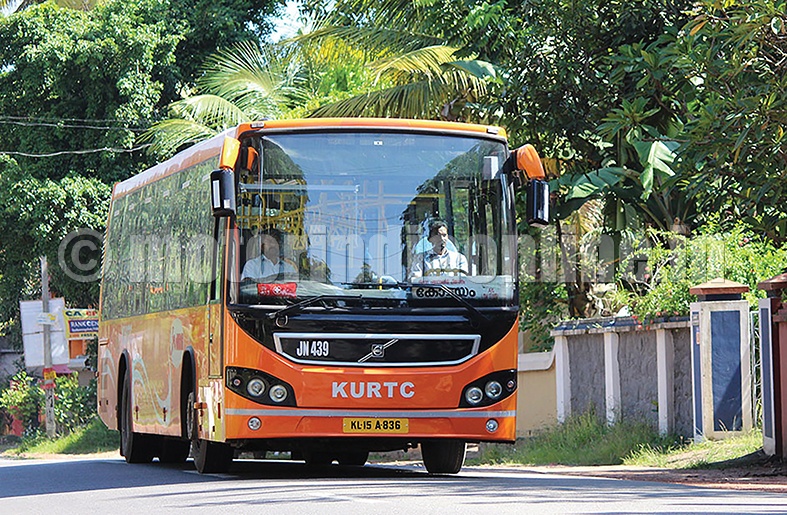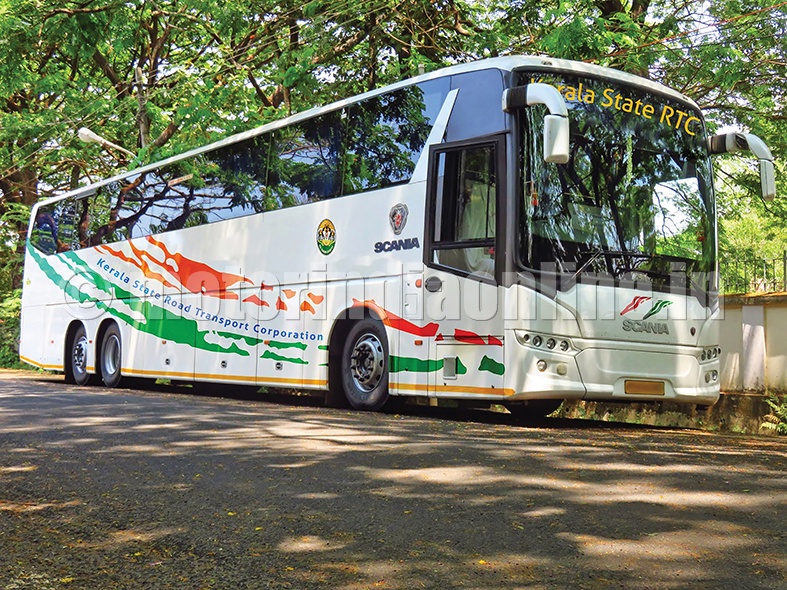The Kerala State Road Transport Corporation (KSRTC), the erstwhile Travancore State Transport Department, was constituted by the Travancore Government in 1937. From a humble start with 30 Comet chassis, the company today has more than 6,000 vehicles in its fleet, including double-decker buses, vestibule buses, and AC and non-AC low-floor buses.
KSRTC recently purchased a fleet of multi-axle buses to fulfil its ambition of ‘going places’. Now it plans to keep getting better with time.
We recently met Mr. Antony Chacko, Chairman and Managing Director, KSRTC, at his Cochin office for detailed insights into the Corporation working.
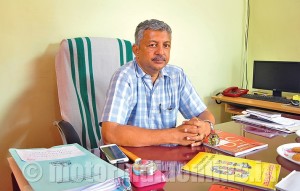
Excerpts:
Let’s start with a background of KSRTC operations. How is business at present? Are there any new developments happening?
KSRTC has a fleet strength of close to 6,000 buses, operating up to Bangalore. Our current revenue is around Rs. 5.5 crores and, during peak holiday seasons we touch close to Rs. 7 crores. We will soon be connecting Kerala with Mumbai, Goa, Hyderabad, Puttaparthi, Pondicherry and Chennai. We are reviewing our inter-State agreement with Andhra Pradesh, Telangana, Goa and Tamil Nadu, and we will soon be starting the operations. We are planning to run high-end buses like Volvo and Scania on these routes and feel there will be very good response from passengers.
Could you tell us about the newly-formed Kerala Urban Road Transport Corporation (KURTC)?
KURTC was formed last year as a Special Purpose Entity (SPE) under the guidelines of the Ministry of Urban Development (MoUD) with 80 per cent funding from the Government of India through MoUD and 20 per cent by the State Government. We mainly run AC and non-AC buses with a fleet strength of 500-odd vehicles and are waiting for the delivery of another 200 buses which would take the fleet strength to 720. Except Ernakulum and Trivandrum, we have divided the State into five clusters and intend to run buses across them. We run a fleet mix of AC and non-AC buses and have come to understand that people prefer AC buses which are remunerative for us as well. The non-AC buses are also low-floor ones and so are comfortable for passengers.
KURTC is giving a big thrust for tourism and in line with this we have launched a new website wherein the AC buses are linked to the tourist locations, and in case buses are not available, the enquiries will be routed to KSRTC.
Until KURTC was formed, we had daily revenue of Rs. 10 to 20 lakhs from two districts – Ernakulam and Trivandrum only. After the formation of KURTC, thanks to the additional fleet, we are touching close to Rs. 60 lakhs every day, and with further addition of new buses, we are aiming to touch the Rs. 1 crore-mark in our daily collections.
Have you taken up any new initiatives?
With the metro rail work going on in full swing, we are planning to connect the metro rail stations with feeder bus services which would enable the passengers to conveniently use the metro trains. The feeder buses reach commuters’ doorsteps, which makes it a very attractive option. In the long run, we intend to cover most parts of Kerala with KURTC buses, and having invested in high-class buses, we wish passengers move from private transportation to public transportation as it would reduce congestion within cities in a big way.
How effectively have you utilized the JnNurm funds?
We have not wasted a single rupee that was allocated to us through the JnNurm scheme, mainly because we have submitted all the documents required by the MoUD on time. We have utilized the funds under three heads – for buses, for infrastructure, and for Information Technology Enabled Service (ITes). We have depots in 92 locations having workshops to handle daily and periodic maintenance and also have one central and four regional workshops which can handle overhauling and other major repair of buses.
We understand you have inducted Eicher and Scania buses and have branded some of your buses as ‘Silverline Jets’. How are these vehicles performing?
The Eicher buses which were recently inducted are doing well. We want to see how they perform in the long run. The Scania buses are currently under trail and have also done well so far.
The Silverline jet is a fast-moving non-AC bus which is placed above deluxe bus. These buses start from Trivandrum and run up to Kasaragod, connecting two ends of Kerala. This is basically a limited stop bus with only nine stops because of which we are able to cover long distances quickly. These buses are equipped with Wi-fi and CCTV cameras which makes the journey comfortable and safe for passengers.
Are you looking for any new type of buses from vehicle manufacturers?
We would like manufacturers to come out with double-decker buses for inter-city operation. We are actually looking for these buses for ultra-long distance routes, wherein we will have passengers in the upper deck and other amenities in the lower deck. These buses could improve the comfort level for passengers.
How do you find the performance of multi-axle buses? How do you work towards increasing occupancy in your vehicles?
The occupancy levels in multi axle buses were slightly less. We are trying to overcome it by appointing franchisees who can book tickets outside Kerala, as a result of which we would be able to pick up passengers even from Coimbatore on our Ernakulam-Bangalore buses. We had only one terminal operating from our satellite bus stand in Bangalore, but now we have added three more locations in Bangalore – Shanti Nagar, Kalasipalayam and Peenya – and can cover various parts of the city. We have also set up reservation centres at six locations in Bangalore.
What is the current status of bus body code implementation at KSRTC?
We have five bus body building plants and all of them would be certified with CIRT; we are prepared for the same. Even now we build bodies systematically as per stipulated norms and are not too far from the practices recommended by CIRT, so we are quite confident.
What are your sources of additional revenue? How do you plan to increase them further?
KURTC relies on KSRTC for its bus stations and we pay them on the basis of floor space utilized. We get additional revenue through advertisement spaces on our buses. Apart from that, we offer Wi-Fi connectivity in our buses which also generate revenue.
Do you have plans to introduce smart cards for passengers?
We are planning to provide smart cards which will greatly enhance the way passengers travel. These smart cards are multi-modal, so they can be used for transportation, purchase of groceries, etc. We are also investing in GPS in buses with which passengers will be able to precisely track the location of the buses, and once they book tickets, they would continuously receive alerts on the movement of buses.
Do you interact with passengers on a regular basis? Could you highlight some of the amenities you provide them?
We are in touch with our passengers and communicate with them by mail through our control room, while complaints are handled by our vigilance and customer service team. I am also personally available to talk to the passengers. In case of long-distance buses, my personal secretary speaks to the passengers randomly to find out their experience in traveling in our buses. We are covering Madurai, Palani, Cumbam, Velankanni, Tenkasi and many other parts in Tamil Nadu and want to eventually reach Pondicherry.
We have tied up with courier companies for parcel delivery and have also partnered a hotel chain called ‘Indian Coffee House’ with the aim of providing our passengers all necessary amenities, including hygienic toilets. We also have Cafe Coffee Day setting up shop at two locations and KTDC establishing their stores across our bus stands. IOCL and HPCL are setting up retail spaces in our bus stands, which offer an additional source of amenities for our passengers.
Last question. How do you want this organization to look five years from now?
Our mission would primarily be to professionalize the organization in a big way. We currently have huge debt and are in the final stages of swapping the existing high interest short-term loan with low interest long-term loan. This will greatly enhance our cash flows though we would be making payments as usual. The Government is supporting us on the pension plan and has also agreed to allow us to collect cess for the social security of our employees. This will greatly reduce the gap between income and expenses and will help us well.
